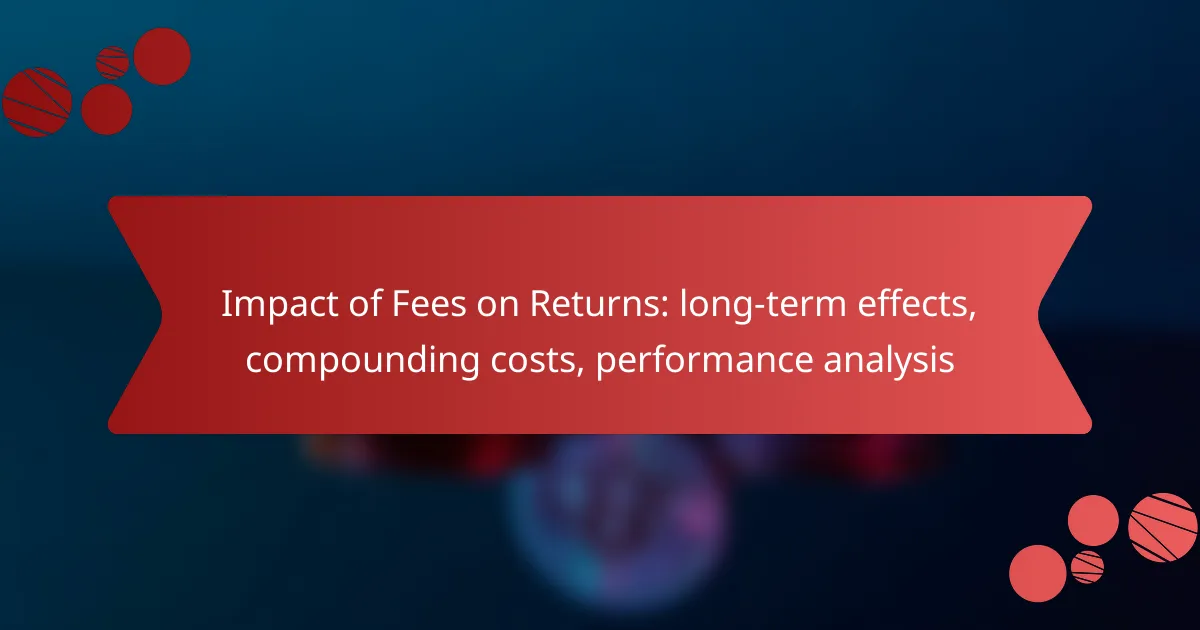Understanding the impact of fees on investment returns is essential for any investor aiming to maximize their portfolio’s growth. Even minor fees can compound over time, leading to significant reductions in long-term returns. By analyzing net returns, which factor in these fees, investors can make more informed decisions and better assess the true performance of their investments.
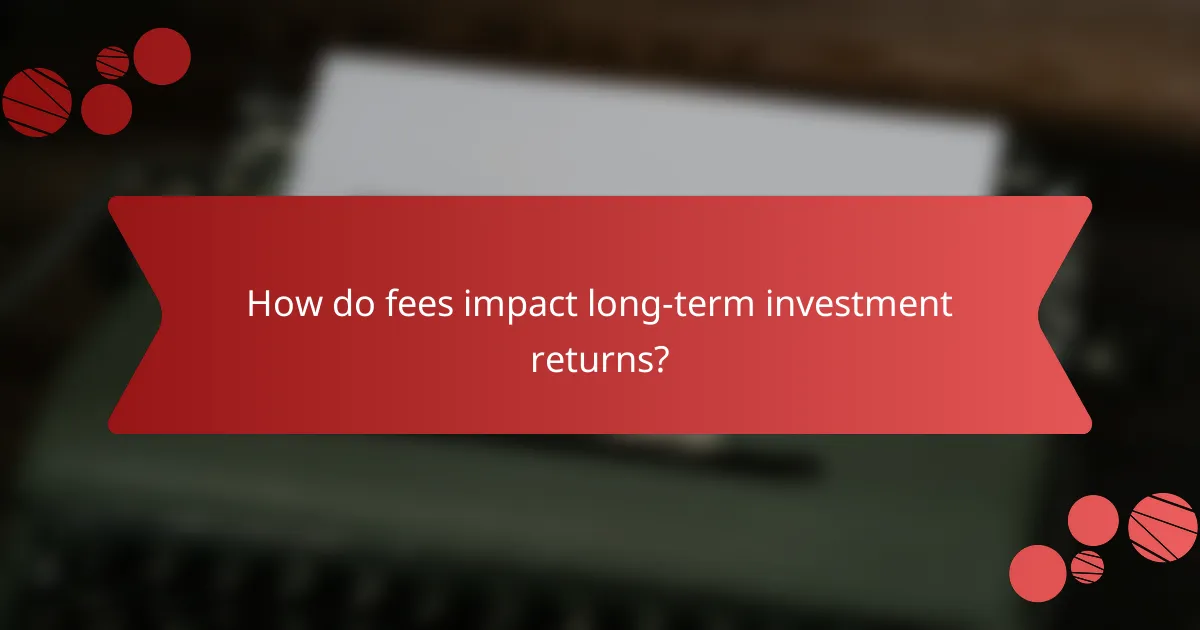
How do fees impact long-term investment returns?
Fees can significantly reduce long-term investment returns, affecting the overall growth of your portfolio. Even seemingly small fees can compound over time, leading to substantial differences in the final value of investments.
Reduction in overall gains
Investment fees, such as management fees and trading costs, directly reduce the gains you realize from your investments. For example, if an investment returns 7% annually but incurs a 1% fee, your effective return drops to 6%. Over decades, this seemingly minor difference can lead to tens of thousands of dollars lost in potential gains.
To illustrate, consider a $10,000 investment growing at 7% over 30 years. Without fees, it would grow to about $76,000. With a 1% fee, it would only reach approximately $57,000. This highlights the importance of understanding and minimizing fees to maximize your investment growth.
Increased time to reach financial goals
High fees can prolong the time it takes to achieve financial goals, such as retirement or buying a home. When fees eat into your returns, it requires a larger initial investment or a longer investment horizon to reach the same financial target. For instance, if you aim to accumulate $1 million for retirement, higher fees could mean needing to invest more money or waiting longer to achieve that goal.
To mitigate this, consider low-cost investment options like index funds or ETFs, which typically have lower fees compared to actively managed funds. Regularly review your investment fees and adjust your strategy to ensure you stay on track to meet your financial objectives efficiently.
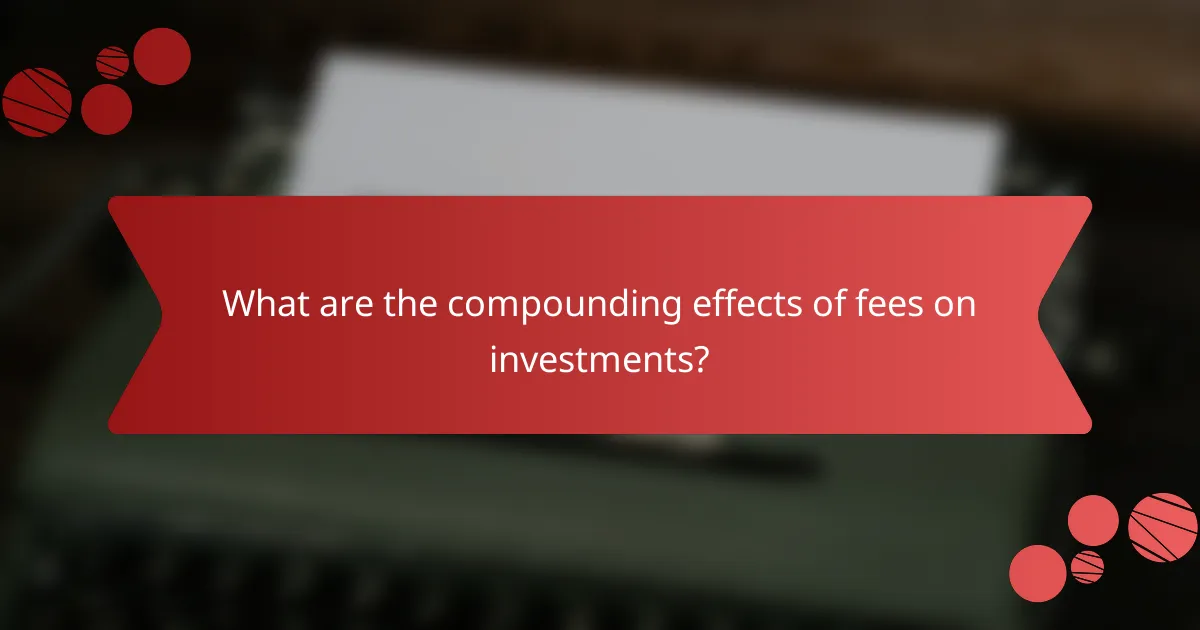
What are the compounding effects of fees on investments?
The compounding effects of fees on investments can significantly reduce overall returns over time. Even seemingly small fees can accumulate, leading to substantial losses in the long run due to the nature of compounding interest.
Exponential growth of costs over time
Fees on investments often grow exponentially, meaning that as your investment grows, the fees also increase, compounding the impact on your returns. For example, a 1% annual fee might seem minor, but over several decades, it can erode a significant portion of your investment gains.
To illustrate, consider an investment of $10,000 with a 7% annual return. After 30 years, without fees, it could grow to about $76,000. However, with a 1% fee, it might only reach around $57,000, showcasing the dramatic effect of fees over time.
Impact on retirement savings
Fees can have a profound impact on retirement savings, often leading to lower nest eggs than anticipated. For instance, if you are saving for retirement over 30 years, even a small percentage fee can result in tens of thousands of dollars less at retirement age.
To maximize retirement savings, it’s crucial to choose investment options with lower fees. Regularly review your investment accounts and consider switching to lower-cost alternatives, such as index funds or ETFs, which typically have lower management fees compared to actively managed funds.
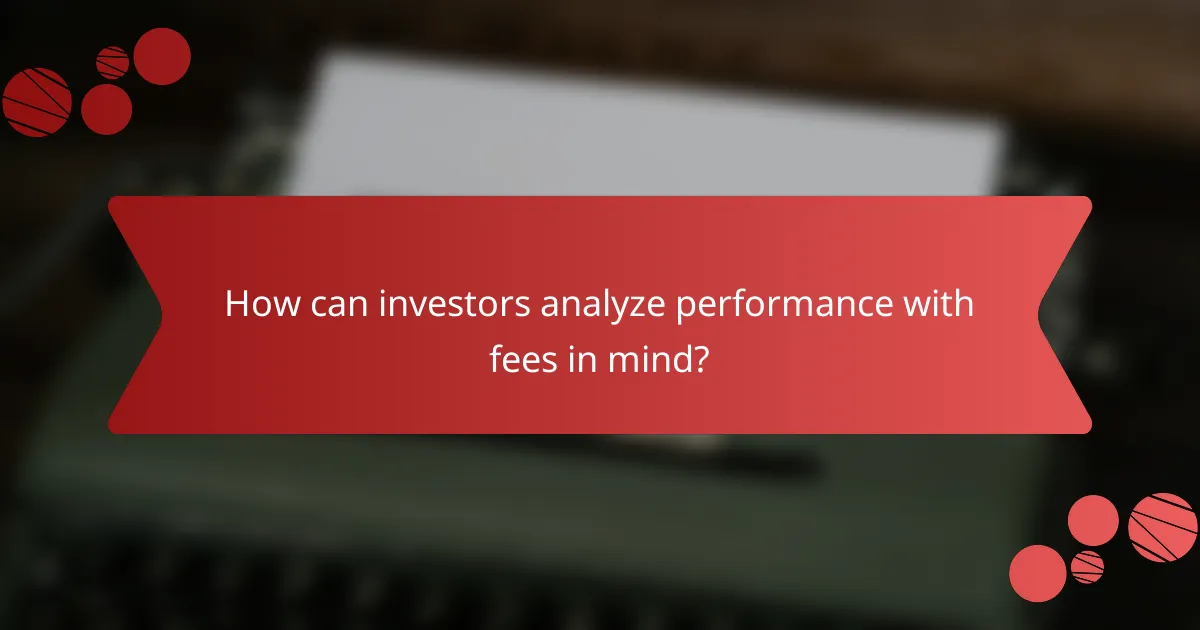
How can investors analyze performance with fees in mind?
Investors can analyze performance by comparing net returns, which account for fees, to gross returns, which do not. Understanding the impact of fees on overall returns is crucial for making informed investment decisions.
Comparison of net returns vs. gross returns
Net returns reflect the actual profit an investor receives after all fees are deducted, while gross returns show the performance before any costs are taken into account. For example, if an investment earns 8% gross but incurs 2% in fees, the net return is effectively 6%. This distinction is vital for assessing the true performance of an investment.
Investors should regularly compare net and gross returns to gauge the effectiveness of their investment strategies. A consistent pattern of high gross returns but low net returns may indicate excessive fees that could erode long-term growth.
Use of fee-adjusted performance metrics
Fee-adjusted performance metrics, such as the Sharpe ratio adjusted for fees, provide a clearer picture of risk-adjusted returns. These metrics help investors understand how fees impact their investment’s performance relative to its risk. For instance, a fund with a high gross return but significant fees may have a lower fee-adjusted Sharpe ratio compared to a fund with lower gross returns and fees.
When evaluating funds or investment options, consider using fee-adjusted metrics to make more informed comparisons. This approach can highlight funds that may appear attractive based on gross returns but underperform when fees are factored in, guiding better investment choices.

What strategies can minimize the impact of fees?
To minimize the impact of fees on investment returns, consider strategies that focus on low-cost options and automated services. These approaches can help retain more of your investment gains over time, enhancing overall performance.
Choosing low-cost index funds
Low-cost index funds are designed to track the performance of a specific market index while maintaining minimal fees. By investing in these funds, you can significantly reduce the costs associated with active management, which often includes higher expense ratios.
When selecting index funds, look for those with expense ratios below 0.2% as a general guideline. This can lead to substantial savings over the long term due to the power of compounding, where even small differences in fees can result in tens of thousands of dollars in savings over decades.
Utilizing robo-advisors with lower fees
Robo-advisors offer automated investment management services at lower fees compared to traditional financial advisors. They typically charge annual fees ranging from 0.25% to 0.5%, making them an attractive option for cost-conscious investors.
When choosing a robo-advisor, consider the services they provide, such as tax-loss harvesting or automatic rebalancing, which can enhance your investment strategy. Ensure that the fees align with the value of the services offered to maximize your returns while minimizing costs.

What are the key criteria for selecting investment options?
When selecting investment options, key criteria include understanding fee structures, analyzing historical performance, and evaluating risk levels. These factors significantly influence long-term returns and overall investment success.
Fee structure transparency
Fee structure transparency is crucial for making informed investment decisions. Investors should seek options where all fees, including management fees, performance fees, and any hidden costs, are clearly disclosed. This clarity helps in assessing how fees will impact overall returns over time.
For example, a fund with a management fee of 1% may seem reasonable, but if additional performance fees apply, the total cost can significantly erode returns. Always compare fee structures across similar investment options to identify the most cost-effective choices.
Historical performance analysis
Analyzing historical performance is essential for evaluating potential investment options. Look for funds or assets that have demonstrated consistent returns over multiple market cycles, as this can indicate resilience and effective management. However, past performance is not always indicative of future results.
When reviewing historical data, consider a time frame of at least five years to get a clearer picture of performance trends. Additionally, compare the performance against relevant benchmarks to assess whether the investment is truly adding value or simply tracking the market.
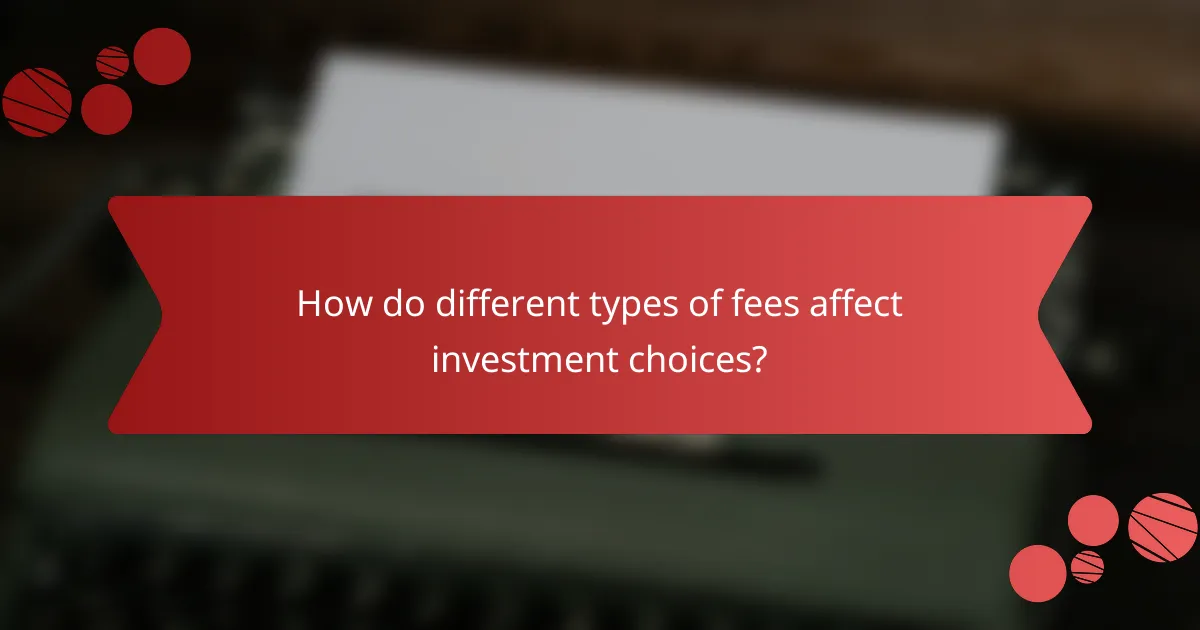
How do different types of fees affect investment choices?
Different types of fees can significantly impact investment choices by influencing net returns and overall performance. Understanding how management fees, performance fees, and transaction fees work is crucial for making informed investment decisions.
Management fees vs. performance fees
Management fees are typically charged as a percentage of assets under management, often ranging from 0.5% to 2% annually. These fees cover the costs of managing the investment portfolio and can reduce overall returns over time due to compounding effects.
Performance fees, on the other hand, are charged based on the investment’s performance, usually as a percentage of profits above a certain benchmark. While they can incentivize managers to achieve better results, they may also lead to higher costs during successful periods, impacting long-term returns.
Transaction fees in active trading
Transaction fees are incurred each time a trade is executed and can vary widely based on the brokerage or trading platform. These fees can add up quickly, especially for active traders, potentially consuming a significant portion of returns.
Investors should consider using platforms with low or no transaction fees for frequent trading. Additionally, understanding the fee structure can help in making strategic decisions about when and how often to trade, ultimately preserving more of the investment’s gains.
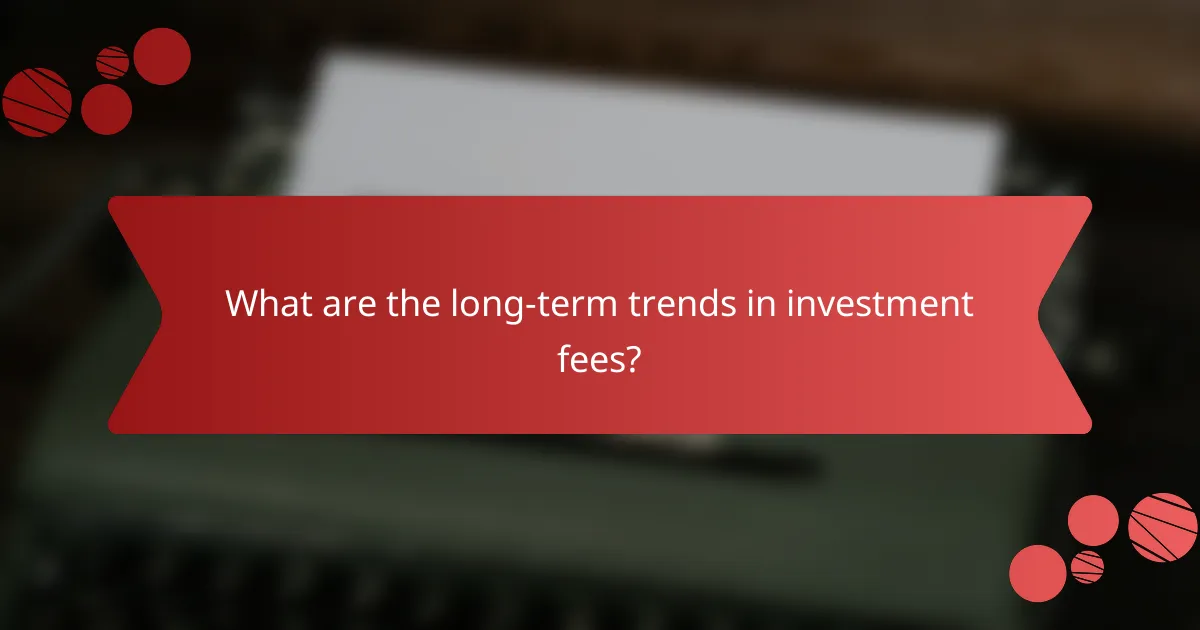
What are the long-term trends in investment fees?
Long-term trends in investment fees show a general decline, particularly as investors increasingly seek cost-effective options. This shift is largely driven by the rise of passive investment strategies and regulatory changes aimed at increasing transparency and competition in the financial markets.
Shift towards passive investment strategies
The shift towards passive investment strategies has significantly impacted investment fees. Passive funds, such as index funds and exchange-traded funds (ETFs), typically charge lower fees compared to actively managed funds, often by a margin of several percentage points. This cost advantage can lead to higher net returns over time due to the effects of compounding.
For example, if an actively managed fund charges 1.5% annually while a passive fund charges 0.2%, the difference can accumulate substantially over a long investment horizon. Investors should consider the fee structure when choosing between active and passive options, as lower fees can enhance overall performance.
Regulatory changes affecting fee structures
Regulatory changes have played a crucial role in shaping investment fee structures. In many regions, regulations now require greater transparency regarding fees, helping investors make more informed decisions. For instance, the U.S. Department of Labor’s fiduciary rule mandates that financial advisors act in the best interest of their clients, which can lead to lower fees and better alignment of interests.
Additionally, some countries have implemented measures to limit the fees that can be charged in retirement accounts, promoting lower-cost investment options. Investors should stay informed about local regulations that may affect the fees they pay, as these changes can have lasting implications for their investment returns.

